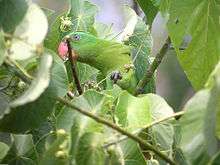Blue-naped parrot
| Blue-naped parrot | |
|---|---|
 | |
| At Walsrode Bird Park, Germany | |
| Scientific classification | |
| Kingdom: | Animalia |
| Phylum: | Chordata |
| Class: | Aves |
| Order: | Psittaciformes |
| Superfamily: | Psittacoidea |
| Family: | Psittaculidae |
| Subfamily: | Psittaculinae |
| Tribe: | Psittaculini |
| Genus: | Tanygnathus |
| Species: | T. lucionensis |
| Binomial name | |
| Tanygnathus lucionensis (Linnaeus, 1766) | |
The blue-naped parrot (Tanygnathus lucionensis), also known as the blue-crowned green parrot, Luzon parrot, the Philippine green parrot, and locally known as pikoy, is a parrot found throughout the Philippines.
Description
This is a medium size parrot (31 cm), primarily green except for a light blue rear crown and nape, pale blue lower back and rump, scalloped shoulders with orange-brown on black coverts, and blackish underwings with green underwing coverts.[2]
Distribution and ecology
The species is widespread throughout the Philippines, including the Talaud Islands and islands off north and east Borneo (with introduced population in Borneo itself, e.g. Kota Kinabalu). It is found in secondary forest, at forest edges and in plantations at elevations of up to 1000 m. Flock size is usually under a dozen. The blue-naped parrot feeds on mangoes, berries, seeds, nuts and grains. It nests in tree holes.[1]
Conservation
Habitat loss and trapping have has made this species scarce on most islands except Mindoro and Palawan.[1] The Katala Foundation has raised concerns over the increasing illegal trade of this bird on Palawan.[3]
Taxonomy
There are currently five recognized subspecies. Others are now generally considered invalid.
- T. l. lucionensis: Luzon and Mindoro
- T. l. hybridus: Polillo Islands. Blue on crown less extensive, tinged with violet. More green on wing coverts.
- T. l. salvadorii: Rest of Philippines.
- T. l. horrisonus: Maratua.
- T. l. talautensis: Talaud.
Gallery
-

In Luzon, the Philippines
-

Three hand-reared chicks
References
- 1 2 3 BirdLife International (2012). "Tanygnathus lucionensis". IUCN Red List of Threatened Species. Version 2013.2. International Union for Conservation of Nature. Retrieved 26 November 2013.
- ↑ Juniper, T.; Parr, M. (1998). Parrots: A Guide to Parrots of the World. New Haven and London: Yale University Press. ISBN 0-300-07453-0.
- ↑ "Palawan’s wildlife faces extinction risk due to mining, pet trade". Mongabay. 17 September 2008.
Further reading
- Dickinson, E.C.; Kennedy, R.S.; Parkes, K.C. (1991). The birds of the Philippines: An annotated check-list. British Ornithologists' Union Check-list. No. 12.
- Kennedy, R.S.; Gonzales, P.C.; Dickinson, E.C.; Miranda, Jr., H.C.; Fisher, T.H. (2000). A Guide to the Birds of the Philippines. Oxford and New York: Oxford University Press. ISBN 0-19-854668-8.
External links
- Oriental Bird Images: Blue-naped parrot Selected photos

